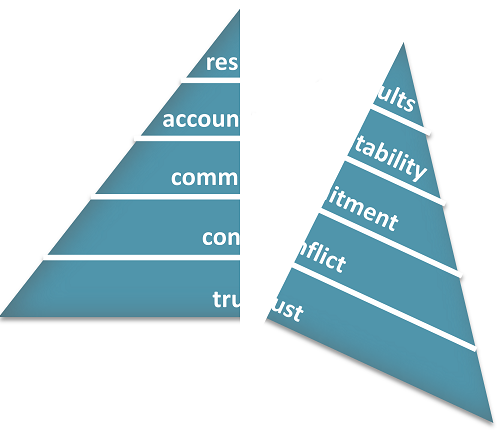Culture@Work
Welcome! My name is Joost Thissen and I am an Interculturalist. Here I share intercultural insights for those of us who work in culturally diverse and global workplaces.


Welcome! My name is Joost Thissen and I am an Interculturalist. Here I share intercultural insights for those of us who work in culturally diverse and global workplaces.


cultural column  Email This Post
Email This Post
There are valuable theories and tools in the field of management: being able to integrate tools from different and specialised disciplines allows for clearer insights. I like to share ideas on how to synergise management and cross-cultural management tools to gain clearer insights and more complete information to help improve the performance of multicultural and global teams.
We know that certain behaviour can make (functional behaviour) or break (dysfunctional behaviour) team effectiveness.
I am not talking about toxic behaviour where people manipulate those around them to get what they want: this includes lying, bending the truth, exaggerating, and leaving out information. Preferably, those personal traits should be recognised and dealt with straight away.
I am talking about dysfunctional behaviour: Lencioni, in his book The five Dysfunctions of Teams (2002) explores work team dynamics and offers solutions to help teams perform better; he suggests that we should explore five vital functions when a team shows dysfunctional behaviour: trust, conflict, commitment, accountability and results.
Vital functions and dysfunctional behaviour: outcomes and indicators

According to Lencioni, absence of trust is the most severe dysfunction that a team can have, he states:
“without trust, productive work and growth are almost impossible. Team members spend time and energy protecting themselves or undermining each other, instead of focusing on the work and goals of the team”.
Lencioni, 2002, The Five Dysfunctions of Teams
Lencioni’s indicator for functional behaviour is to foster trust: asking for help, sharing weaknesses, and believe everyone is trying their best.
When we include findings from cross-cultural models and tools such as for example Meyer’s practical Culture Map (2014), we learn that some of the trust outcomes and its indicators might not even be perceived the same way across cultures, nor that there is one way to overcome them.
Task-based trust
In most Anglo and Northern European cultures, trust, according to Meyer, is foremost perceived as task-based trust: you need to build and keep trust by showing responsiveness, being able to give and receive constructive feedback, take ownership for results, and follow-through on commitments.
Relationship-based trust
In most Asian, South American, Middle Eastern, and some South European cultures, trust is foremost perceived as relationship-based trust according to Meyer: you need to build and keep trust by developing informal contacts, showing positive approach and feedback, face-saving considerations to keep harmony, and reciprocity.
While Lenioni says that functional behaviour in fostering trust includes asking for help, sharing weaknesses, and believe everyone is trying their best, Meyer’s mapping shows that people across cultures have different expectations about how to best build and keeping trust. In multicultural and global teams, building and maintaining trust requires different strategies.
Be forewarned when trying to implement trust as a foundation: we better integrate general and cross cultural management tools to gain clearer insights when looking at vital functions in multicultural and global teams.
Assurance of conflict, display commitment, and take accountability
Following this exercise of integrating a Lencioni’s vital functions and Meyers’s Cultural map to explore trust as being dysfunctional, we also need to look at the other areas and indicators:
Personality and Culture
Brett, Behfar and Kern argue in their HBR article Managing Multicultural Teams (2006) that in general, team leaders and members who recognise and can see challenges as stemming from culture, not personality, better succeed in solving culture-based problems.
When you recognise cultural differences, you are better able to de-personalise the challenge in multicultural and global teams: rather than only an individual behaving differently, you are learning about differences that seemed to be preferred and shared by a group of people (the collective). That allows for exploring better solutions to integrate the cultural differences for all global team members.
Lencioni reminds us that in theory, building cohesive and effective teams is simple, but in practice, teamwork is difficult due to dysfunctional behaviour. Meyer shows us with her Culture Map that managing high performing global teams asks for a deep understanding of the impact of culture on vital functions and preferred behaviour.
Integrate tools for high performing global teams: team members can better re-align differences and harvest the benefits of cultural diversity in global teams, such as innovation and creativity, and offering unique perspectives that enrich problem-solving processes*.
This leads to positive outcomes and functional behaviour, i.e., trusting one another, engaging in conflict around ideas, committing to decisions, holding one another accountable, and ultimately, achieving collective results.
This for sure helped multicultural and global teams that we work with.
Reference
*Yousef, K. 2024, Exploring the impact of cultural diversity in global projects: A comparative analysis of virtual and face-to-face teamwork, The International Journal of Cross Cultural Management.
____________________________________
Joost Thissen, Partner & Interculturalist
joost@cultureresourcecentre.com.au
cultural column  Email This Post
Email This Post